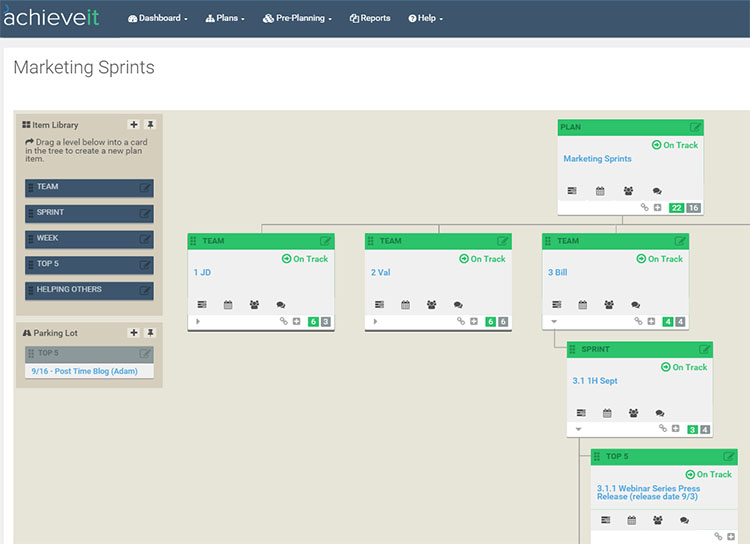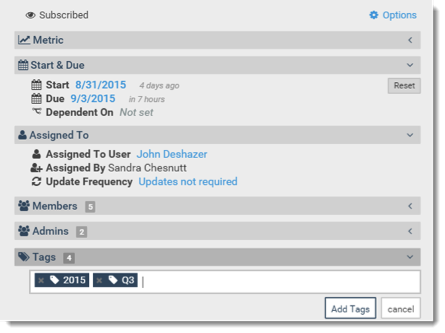Like many teams, the Marketing team at Achieveit has some big, annual goals and we wanted to work together as a team to achieve them. We had a question:
“How to organize the priorities of each member of our team, each sprint, to be sure we were all focused on achieving our most important longer-term team goals?”
Like many teams, the Marketing team at AchieveIt has Annual and Quarterly goals and key Quarterly initiatives. Let’s call them our Big Goals. Our team members are focused on our Big Goals, but we break the work down into sprints by person. Some members of our team work in weekly sprints; others in 2-week sprints. At the beginning of each sprint, each team member maps out his or her Top 5 goals or tasks for that sprint.
Here’s what I wanted to do:
- Tie each of these Sprint Goals to our Big Goals.
- Keep it simple.
First Decision
My first decision was to decide to use two plans. Every time I thought about adding our task-level work (multiple sprints, with multiple tasks for multiple people) into the plan where we housed our Big Goals, it felt overwhelmingly complicated. I really wanted to keep everything in one giant plan but it was information overload.
Instead, I created a second plan for Sprints. This plan is super easy for our team to use in organizing their work. I call this plan “Marketing Sprints.” In the tree view, each person on the team has his/her own branch. Under each person, I added a level for “Sprint” and each sprint has a simple identifier, e.g., the 2-week sprint for the first half of September is labeled “1H Sept.”
Next, I added the level “Top 5.” For the next sprint, Bill can easily add a new sprint labeled “2H Sept” and add 5 new cards for his Top 5 that sprint (or 6 or 7, because…let’s be real.) The whole team can see each other’s Top 5s and can contribute and work together within each card.
Tying back to the Plan
I knew the solution would involve Tags but it took me some time to figure out the best way. My final decision was to use Bulk Edit to add the following tags to every item in the sprint “1H Sept.” These were the tags I created and used “2015” and “Q3”:
I then created a tag for each of our Big Goals. I used a word or brief phrase that would be easy to remember. For example, for the goal “Increase our weekly demos to XX per week,” I just created the tag “InBound.” Again using the bulk edit I took a couple of minutes and added these tags as needed to the current sprint cards. Going forward, everyone on the team can add these as they add their Top 5 cards each sprint.
Now, what about tracking progress on the Big Goal Plan
As you might expect, I am always looking at our Big Goals plan to make sure I am doing a good job of goal management. For one thing, goals change – at least at the Quarterly Initiatives level. Some Initiatives get added and some drop off. At any point in time, we usually have around 20 to 30 quarterly Initiatives. To update their status, I set up bi-weekly notifications to the team member assigned to that Initiative requesting a status update.
Did I keep it simple?
Yes! I am in love with this solution.
Everyone on the team can see their work in the way they think about it: This is me; this is my current sprint, these are my Top 5. Plus each team member has to be intentional about tying his or her task back to one of our three annual goals and the corresponding quarterly goal.
What’s in it for me?
Can I easily get a picture of who is doing what and manage approvals and updates right in our sprint plan? Yes. I just use the tree view of the Sprint Plan and dig in as needed.
Can I easily make sure team members have tied every sprint task to a Big Goal? Yes. Using the list view and filters I can make sure everything is tied back.
Can I look at a single Quarterly Goal and see everything that we have going on to tackle and nail it? Yes. Can I look at the data by Team Member or by Status? Yes. List view and filters make this easy.
Using goal management software helps our team stay focused every week on our long-term goals.








